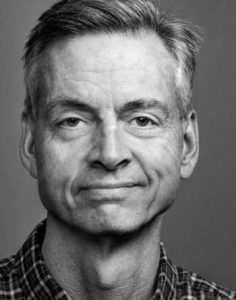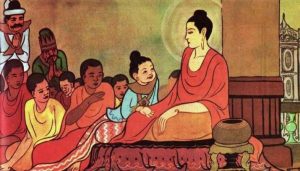
Rejecting the contrary teachings of men and bodhisattvas
Pure Land Buddhism is classed as a difficult-to-believe teaching because it bears the message of Amitabha’s deliverance. One of the reasons for this difficulty is the fact that this teaching is based on faith, so it is not surprising if a Pure Land practitioner has intellectual doubts upon first hearing the teachings. But instead of following the teachings and interpretations passed down to us by the patriarchs, he may first cross-check this “other-power” teaching with other Buddhist sutras, hoping that he can eliminate his doubts through learning.
He may also ask advice from his family, friends, good teachers, and authoritative masters. However, almost all of them are ordinary beings with unenlightened, delusive minds and limited wisdom. As a result, the more he studies and consults with others, the more doubts he has.
Amitabha is a Buddha who is perfect and complete in practice and wisdom. A Buddha is one who fulfills the aspirations of sentient beings with his great compassion, and his words embody truth. No other type of sentient being in the Nine Realms is perfect in both wisdom and virtuous practices. Compared with the unfathomable wisdom of a Buddha, the logic of ordinary beings is infinitely inferior. Because they have not cleared the twofold obstruction of views and afflictions, ordinary beings can only guess at the deepest meanings of the Dharma. Their understanding is bound to be incorrect and biased—though they can, at times, succeed in a partial analysis of the teachings based on logic and reason.
When Master Shandao introduced the seventh kind of deep faith—“establishing faith in the context of persons” (in his explication of the Deep Mind in the Commentary on the Contemplation Sutra)—he advised us to rely on the Buddha’s words alone. As the Buddha’s words form right teaching, right meaning, right practice, right interpretation, right karmic practice, and right wisdom, we should not rely on bodhisattvas and human or celestial beings to tell us what is right or wrong.
The Buddha’s teaching on Amitabha’s deliverance is final and ultimate; all words spoken by bodhisattvas and others are “non-ultimate teachings.” In his commentary, Master Shandao further tells us the consequences of seeking advice from non-perfect beings. He concludes the section on the seventh kind of deep faith as follows:
I sincerely advise all those who have the karmic conditions to aspire to rebirth, to deeply believe the Buddha’s words alone, and to follow his teachings. Don’t believe and follow the contrary teaching of any bodhisattva that may hinder you with doubts, lead you into a maze of confusion, and cause you to lose the great benefit of attaining rebirth [in the Pure Land].
Faith in Amitabha’s deliverance is not based on our own feelings, and it cannot be manufactured by one’s deluded mind. Faith in the Buddha’s deliverance is based on belief in the attainment of Buddhahood by Dharmakara, the final mortal rebirth of Amitabha Buddha.
Dharmakara’s accomplishment of the 48 Vows, particularly the 18th Vow, is a true and real fact that becomes the content of our faith. This faith does not originate from one’s thoughts or feelings. It is based on a single, objective fact: the real existence of the measureless Amitabha Buddha. Once we have heard Shakyamuni’s teaching on the Pure Land way, and encountered the living Amitabha through “Namo Amitabha Buddha,” we are naturally able to have faith in his Buddhahood, vows, and deliverance.
Different understandings and different teachings
Later in the section on the seventh kind of deep faith, Master Shandao writes:
Further, the deep trust that is associated with the deep mind is to decisively perform practices in accord with the Buddha’s teaching. This means to cast out doubt and error forever, and to never be discouraged or dissuaded by those of different understanding, different practice, distant teachings, distant views, or distant disciplines.
What is meant by different understandings? What is meant by different practices?
Master Huijing explains as follows: “The principal objective of Pure Land teaching is that sentient beings must be reborn if they recite Amitabha’s Name. Anybody can do it, so it is known as a teaching that ‘universally covers beings of the three virtuous roots (upper, medium, and lower).’ All sharp- and slow-witted beings are accommodated; thus, 10,000 people will achieve rebirth if 10,000 people practice it.”
He continues: “If people hold different opinions, they think that to be reborn one must add other virtuous practices in addition to Amitabha-recitation. Or they think one must reach a certain level of proficiency in their Amitabha-recitation practice. Though such persons are said to practice the Pure Land teachings, their understanding differs from the Shandao tradition. This is known as a ‘different understanding.’ Because of a different understanding, their practice is also different. Thus, we speak of ‘different understanding, different practice.’”
Distant teachings, distant views, and distant disciplines
What is meant by distant teachings, distant views, and distant disciplines? Master Huijing explains:
“Distant means ‘totally different.’ What this person studies may be the Sagely Path, other traditions of Pure Land Buddhism, or religions other than Buddhism. These are known as ‘distant teachings.’ The teachings they study are distant, and their views are likewise distant. Thus, they are known as ‘distant views.’ And of course, those with teachings and views that are distant will insist that what they practice is correct, and regard other practices to be incorrect. This is known as ‘distant discipline.’”
Pure Land practitioners should not be disturbed by people who take the Sagely Path and the self-powered bodhisattva practices. They should establish deep faith in what Shakyamuni Buddha taught in the three Pure Land sutras. Without becoming discouraged or dissuaded, they should hold fast to “Namo Amitabha Buddha” for the attainment of assured rebirth in the Land of Bliss.
Pure Land Buddhism as a teaching of deliverance, not a teaching of cultivation
In our world, which is governed by causal conditions and characterized by impermanence, only Amitabha’s great six-character Name is real and permanent. It is the crystallization of a myriad of virtuous karmic acts performed by Amitabha Buddha. Truly, the methods of a Buddha’s deliverance are unfathomable, but they can be categorized as follows: deliverance through paranormal mental abilities, deliverance through his body of light, and deliverance through his Name.
Amitabha Buddha delivers sentient beings through his Name. Amitabha Buddha’s Name consists of immeasurable, boundless and inconceivable merit and virtues. It also consists of unimpeded light shining over all the worlds in the Ten Directions. It is for this reason that his Name is also called the Name of Light.
When we exclusively recite his Name, Amitabha Buddha’s light will embrace, receive, and never forsake us. “Embracing and receiving” means protection and deliverance. “Never forsaking” means to never abandon us, and then, at the end of life, receiving us into the Land of Bliss.











